- Home
- Jack Canfield
Chicken Soup for the Soul Celebrates Teachers Page 2
Chicken Soup for the Soul Celebrates Teachers Read online
Page 2
As we began singing, most of the residents stared off at the walls or floor. It seemed as though my premonition was going to be right. However, one lady caught my eye. She was sitting by the door, in a wheelchair, singing songs to herself. They weren’t the songs that we were singing, at least they didn’t sound like it. As we got louder with each festive song, she did likewise. The louder we got, the louder she got. As she was singing, she was also reaching out to us with her hands and body. I knew that I should have gone over to her, but I thought that my responsibilities were to my students. People who worked at the care center could attend to her, I thought. Just when I stopped feeling guilty about not giving her the attention she needed, one of my students, Justin Proctor, showed me what the holiday season is really about.
Justin noticed the same lady by the door. The difference between us is that he acted on her needs, and I didn’t. During the last song, “Silent Night,” the lady was singing the loudest that her lungs could let her. She was reaching out as far as she could, almost to the point of falling out of her wheelchair. Justin stopped singing. He walked over to her and grabbed her hand and held it during the rest of the song. He looked this aged lady in her eyes and with his actions said, “You are important, and I will take my time to let you know that.”
This tired, elderly lady seemed to regain, if only for a moment, what she had lost—her memory. She stopped singing and held his hand. She then took her other hand and put it up to his face. She touched his cheek. Tears began to fall down her wrinkled face, as the memories—for that brief moment—began to rush back into her mind. No words can completely portray that poignant moment. It took a boy to teach me, a man, about kindness and love. Justin’s example of complete, selfless compassion toward another was a lesson that I will never forget. He was the teacher that day, and I consider myself lucky to have witnessed his lesson.
Mike Ashton
CLARISSA’S SPACE
I was the new teacher at school, and Clarissa—a gangly, somewhat grouchy fifth-grader—was messy. Clarissa saw no need for order. The more she was asked (even nicely) to straighten up her space, the messier she left it. The more she was reminded sternly to get her space straightened up, the harder she crammed her books, papers, pencils, last week’s snack and everything else into her desk.
“It’s my space!” was most often her response to any reprimand or request from classmates. At times, I was sure I saw a glint of pleasure in her eyes as she dropped a used tissue onto the floor near her desk just to watch her neighbor’s reaction.
So the days went by, with Clarissa’s space creeping ever slowly into the sacred learning space of my other students. This situation couldn’t go on. The complaints began to worsen.
“Good grief! Her stuff is everywhere!” they cried.
“Clarissa, get your purse out of the aisle. I’m tired of tripping over it!” they’d say. I realized she was beginning to alienate herself from her peers. I had to come up with a solution.
One afternoon after she had left, I sat enjoying the peaceful moment that is bliss for all teachers. It’s the time of day when there is suddenly a hush over the classroom and you sit at your desk looking around the room. The problems of the day don’t seem so large. You begin thinking about what paperwork to take home and what to get ready for the next day. The late afternoon sun was gleaming through the window, and I was surveying Clarissa’s space from where I sat. How does she stand it? I thought.
As I continued to sit, I came up with an idea—somewhat like the lightbulb coming on, the sun suddenly streaming through the windows, the heavenly choir singing. It was just an idea, but it might work! But what would her classmates think? What would the veteran teachers say? “Mrs. S., you’re going a bit too far. You’ll learn not to baby your students this way. Send her to the office. She needs to get her act together. Call her parents. Throw out her junk—that’ll teach her to mind you.”
Standing next to the window near my desk was an empty two-drawer filing cabinet. What if Clarissa had her own space— some space that was uniquely her own? Not an old beaten-up desk, but some place really neat.
I began to work. I moved her desk and all her things (including the tissues, the old snacks, the candy wrappers—candy wrappers?) near the cabinet. I selected some clean white construction paper and cut out a place card. On it I wrote, “Clarissa’s Space.” I drew some small flowers—wild violets—purple and green with yellow dots in the middle and set it on top of the filing cabinet. I gathered my things together and headed for home.
Driving to work the next day, I found myself anxious to see her reaction. Would she resent the move? Would she think this plan was stupid? Would it make matters worse? Now she had even more space to mess up.
The next morning she came in the room in a tizzy as usual, already fussing with a classmate. She spotted her new space almost immediately. She stopped and looked silently for what seemed like a long time. Quietly she asked, “Is this mine?”
“It’s for your things if you feel like you need it,” I said nonchalantly, busying myself with papers on my desk.
“I like this card, Mrs. S.,” she said, holding it up and turning it over in her hands.
“Thank you,” I said. “It’s for you. You can keep it.”
Clarissa began organizing her things. She opened the drawers and put things away. She opened the drawers again, taking the items out, rearranging and replacing them. She spent the next hour (forget the spelling, language and reading—this time was that “teaching moment” you hear about in college) setting up her “nest.”
I knew the question would come from her classmates. Sure enough, within only a few minutes a student asked, “How come she gets that?” I had prepared myself for this question.
“Because she needs it. Would you like to offer to help her with her things?” I asked.
The student shrugged his shoulders, put his hands in his pockets, stood watching her for a few moments and walked back to his desk. No more was said. No one asked any more questions. No one seemed to resent it.
Clarissa spent the rest of the year keeping her things together in her space. That was nice. Peace was at hand in our classroom.
The real benefit of this arrangement came in a beautifully simple way. A beaten-up old filing cabinet and a small note card gave a gift to this child. She experienced a real sense of ownership. It gave her a sense of her special place—a sort of haven from the difficulties of the day, the stresses of her school life and her family life.
I have since moved and lost contact with Clarissa. Wherever you are, my dear student, I would ask that you pass on this gift, the gift of creating a different path for someone to walk who might be struggling in some way. It will be the gift of giving someone a sense of ownership, her own space, his own note card.
And don’t forget to add some flowers.
Sandra H. Swindall
TOMMY WAS REAL
Tom my Turtle had become a permanent part of my classroom during the years I taught preschool. I was never able to keep real pets alive, so I created Tommy. He was a small, green, squeaky turtle whose home had become a clear, plastic shoebox, complete with lid and plastic Easter grass. Each year, the children would take turns taking him home for the night. The children loved the thought of taking the class pet home with them! Since we didn’t exactly explain the fact that he wasn’t real before he was sent home, the parents always looked a bit frightened the first time their child carried Tommy’s box to the door to go home. That was just part of the fun!
Although Tommy wasn’t a real turtle, the children all treated him as if he were, and always took good care of him on his visits. The children would feed him dinner, take him for walks and tuck him into his bed at night. When Tommy returned to school with the children each day, he always came accompanied by crayon drawings and photos of his adventures.
Tommy did everything from riding on a four-wheeler to wading in a birdbath. He ate macaroni-and-cheese and Froot Loops for dinner. He watched mo
vies and ate popcorn, and watched as the children brushed their teeth before bed each night. He was there when the children laughed; he was there when they cried. Each year Tommy would soon be returning to school with gifts from the children. Over the years, Tommy received several new blankets, and beautiful, sparkly rocks always decorated his plastic home. One year, he even had a small bowl of plastic lettuce to munch on when he was hungry, and a “pet” plastic fish to keep him company when he grew lonely. Every year, the children came to love Tommy, and every year, Tommy became a little more real.
While the children learned to take care of Tommy, I believe that Tommy took care of a lot of them, too. Several times the children did not have the words to tell me directly when something was wrong, but they were able to tell me through Tommy and his pictures. Even though I was not always able to know the exact reasons behind their behaviors, Tommy helped many of the children find the words to help me understand a little better.
The children’s pictures of Tommy’s visit to their homes helped me to see things I might not have known anything about. Sometimes, Tommy was kept awake all night by a crying baby. Sometimes, he went with a child to spend the night at a divorced parent’s house. Sometimes, he went to bed late and didn’t want to get up in the morning. The “Tommy Pictures” were not always just drawings of him walking in the grass; sometimes they were windows into the homes of my students. Those windows occasionally helped me to see much more than I ever would have without Tommy.
Tommy was made of plastic, and he talked with a squeak when you squeezed him, but he was real to all my preschoolers. He was real to me, too.
R. Lynn Baker
SNOW ANGELS
They wiggled on the floor around my feet signaling the end of the lesson.
“Now let’s remember what we’ve learned today,” I said vying for one more moment of their attention in hopes of proving to myself that I had indeed gotten their attention at all.
Five-year-olds never cease to amaze me. Each afternoon I teach religion in the back of my classroom. Me in a chair, and them around me on the “quiet carpet.” They wriggle and wriggle, fidgeting and squirming as I read to them and pray to them. And do anything else I can think of to educate their minds and nourish their souls. At a glance, you would never guess they were even hearing me, let alone comprehending or “feeling” my objective. But after a few years of doing this, I have finally realized that through an occasional somersault they are hearing, understanding and even feeling.
“We talked about the different ways to pray,” I reminded them. “Who can tell me these ways?” I asked.
“Going to church!” someone shouted.
“Good,” I complimented.
“Saying prayers,” came another. I nodded.
“Singing hymns.”
“Doing good.”
“Reading the Bible.”
“Very good!” I all but squealed. “And why do we do all of these things?” I asked, my voice rising in anticipation.
If only they could answer this last question, I could stamp myself a success. I would know that I had actually taught them something. My stomach almost hurt with the wait.
“To learn about God,” came the reply.
I’d like to say it came from above, but to be completely honest, it came from below, very below. Actually, it came from inside a shirt that the responder had pulled up over his face. I was so relieved to get the answer that I was looking for that I didn’t have the heart to scold him.
“Thank you, Brian,” I noted.
“You’re welcome,” he mumbled still under his shirt.
I let myself smile and leaned back in my chair.
“You really were listening,” I beamed, satisfied. I sat there, basking in what I thought was the end of the lesson.
But God seemed to turn to a precocious brown-haired mop-top, gently laying a hand on his head and whispering “Listen” into his ear. The lesson was not over yet.
“I know why we need to learn about God,” he offered.
“Tell us,” I said, not even giving him my full attention as I began gathering my things.
“So that when we get to heaven to live with him we’re not strangers.”
I stopped my gathering.
“Yeah, because that would be so embarrassing,” another agreed.
“Yeah, because he knows all about us,” someone explained.
The rest nodded in unison. Time stopped for me, but with that they were gone. They went back to their fidgeting, squirming and somersaulting. The shirt-over-the-head fashion caught on and I had lost many of them. I was left alone. I guess the answer had been obvious to them; they had no reason to contemplate more. It was just I who had not entertained this fact, who had to absorb it.
Finally, I smiled and allowed the notion to surround me. I had been pleasantly surprised at receiving the unexpected. I was even a bit embarrassed that they had rewritten my lesson. I wondered where their inspiration had come from. But then casting my eyes heavenward, I think I felt a tap on my own shoulder.
Later that day as I sat alone in my classroom nibbling on my lunch, I spotted the burgundy leather Bible that sat in the corner of my desk. I cringed a bit noticing that a thin layer of dust had accumulated on the cover testifying to my neglect. I was staring at it motionless, caught in my own thoughts, when a clamor from the outside startled me. The children had just been released to recess. I shrugged it off, as this was the ritual every afternoon. I often heard them faintly through the closed window. After another moment, I realized today that it sounded different. It sounded happier. Although the window had been shut tight to the frigid January day, I heard them quite clearly. They certainly were excited. Curiosity getting the best of me, I got up from my seat to see what the extra commotion was all about. Peering out the window, I laughed aloud as I saw every member of my class laying flat on their backs in the snow that had fallen overnight. They were wildly flapping their arms and legs creating snow angel versions of themselves. The nuns who monitored recess scampered, weaving excitedly among them, reprimanding each and ordering them to get up. I laughed louder as I watched them chase each and every one of them back into the building. Once all were inside, the door was slammed so loudly I could hear the sound of the clanging metal from where I stood. As the sound of their laughter lingered then faded away, I stared out of the window at the imprints of snow angels that now dotted the crystal white play yard. I counted them. There were twenty-three. Each child had made one. I blinked stirring myself from my thoughts. I walked from the window and returned to my desk. As I plopped myself into my chair, the smile still lingered on my face.
Out of the corner of my eye, I spotted the Bible again. Grinning heavenward, I whispered, “Okay, okay.” And, after wiping my hands, I picked it up gently. Carefully, I caressed it clean. It had been much too long since I had held it, let alone opened it.
It’s all in here, I thought to myself, everything I need to know about God.
“Yeah, ’cause he knows all about us.” The innocent words still rang in my ears.
I daydreamed myself at the gates of heaven, being welcomed into a glorious paradise by God. And I envisioned myself stepping closer to him as he said, “Welcome, I know all about you.”
I felt the warmth of his embrace and he hugged me.
I heard myself say, “I know all about you, too.”
I picked up the Bible and began to read. I had gotten their attention and they had indeed gotten mine.
Christine Pisera Naman
Excerpted from Once Upon a Classroom
(Thomas More, Spring 2004 Release)
LILIES OF THE VALLEY
When I was seven, my grandma died. I cried at her funeral because my older cousins were crying, not because I was grieving. I was too young to fully understand my loss at that time. But four years later, when I was eleven, one of my best friends died, and I could not stop grieving.
Linda was a beautiful girl with long, brown hair that curled softly on her sh
oulders. She had a warm, friendly smile for everyone and a heart full of kindness. We had slumber parties together, practiced cheerleading, went biking and met at the movies. We loved to sing and to dance. Pretending we were famous ballerinas, we would twirl and glide and leap through the air until we fell to the ground, laughing and exhausted.
When Linda’s appendix burst, no donor could be found in our small town to match her rare blood type. She died in an airplane on the way to a Chicago hospital.
I was overcome with an emptiness that was nearly unbearable. I couldn’t stop crying. Mom came to my room several times throughout that first night, but nothing she said could console me.
The next few days were no better. I cried incessantly, still feeling that hollow loneliness.
On the day of the funeral, Mom took me to church to say a last good-bye to my friend. Linda looked as angelic in death as she was in life. Fragrant lilies of the valley, with tiny, delicate bells, surrounded her casket. They reminded me of the song that Linda and I sang whenever Mom took us to pick wildflowers in the woods:
White silent bells upon a slender stalk Lilies of the valley deck my garden walk Oh, don’t you wish that you could hear them ring That will happen only when the angels sing
The bells will never ring, I thought bitterly, because the angels won’t sing. Who could sing now? Not even angels.
We left before the service began. Mom was afraid I might cry uncontrollably. Perhaps she was right.
The next day at school, when the others went outside for recess, I sat at my desk staring numbly at the windows. I could hear the loud taunts and joking from the playground. How could the others even think of playing when Linda wasn’t there with them? How could they be laughing and having fun? How could life ever be the same? I would never, never smile again. That wouldn’t be fair to my friend.

 Chicken Soup for the Nurse's Soul: Second Dose
Chicken Soup for the Nurse's Soul: Second Dose Chicken Soup for the Ocean Lover's Soul
Chicken Soup for the Ocean Lover's Soul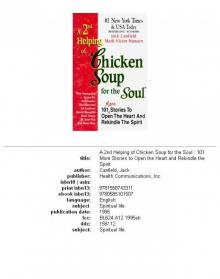 A 2nd Helping of Chicken Soup for the Soul
A 2nd Helping of Chicken Soup for the Soul Chicken Soup for the Nurse's Soul
Chicken Soup for the Nurse's Soul Chicken Soup for the Breast Cancer Survivor's Soul
Chicken Soup for the Breast Cancer Survivor's Soul Chicken Soup for the Pet Lover's Soul
Chicken Soup for the Pet Lover's Soul Chicken Soup for the Bride's Soul
Chicken Soup for the Bride's Soul A Chicken Soup for the Soul Christmas
A Chicken Soup for the Soul Christmas Chicken Soup for the Soul of America
Chicken Soup for the Soul of America Chicken Soup for the Teenage Soul on Tough Stuff
Chicken Soup for the Teenage Soul on Tough Stuff A Taste of Chicken Soup for the Teenage Soul III
A Taste of Chicken Soup for the Teenage Soul III Chicken Soup for Every Mom's Soul
Chicken Soup for Every Mom's Soul Chicken Soup for the Dog Lover's Soul
Chicken Soup for the Dog Lover's Soul A Second Chicken Soup for the Woman's Soul
A Second Chicken Soup for the Woman's Soul Chicken Soup for the Soul the Book of Christmas Virtues
Chicken Soup for the Soul the Book of Christmas Virtues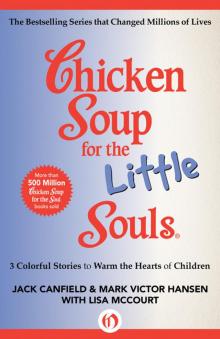 Chicken Soup for the Little Souls: 3 Colorful Stories to Warm the Hearts of Children
Chicken Soup for the Little Souls: 3 Colorful Stories to Warm the Hearts of Children Chicken Soup for the African American Woman's Soul
Chicken Soup for the African American Woman's Soul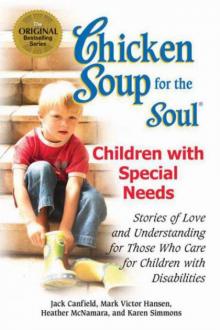 Chicken Soup for the Soul
Chicken Soup for the Soul Chicken Soup for the Soul Celebrates Teachers
Chicken Soup for the Soul Celebrates Teachers Chicken Soup for the College Soul
Chicken Soup for the College Soul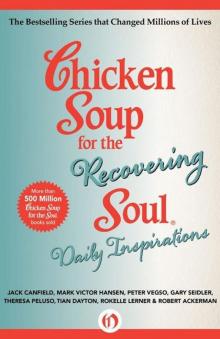 Chicken Soup for the Recovering Soul Daily Inspirations
Chicken Soup for the Recovering Soul Daily Inspirations Chicken Soup for the Soul Celebrates Sisters
Chicken Soup for the Soul Celebrates Sisters Chicken Soup for the Dieter's Soul
Chicken Soup for the Dieter's Soul Chicken Soup for the Soul at Work 101 Stories of Courage
Chicken Soup for the Soul at Work 101 Stories of Courage Chicken Soup for the Beach Lover's Soul
Chicken Soup for the Beach Lover's Soul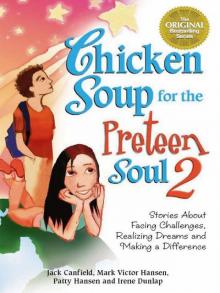 Stories About Facing Challenges, Realizing Dreams and Making a Difference
Stories About Facing Challenges, Realizing Dreams and Making a Difference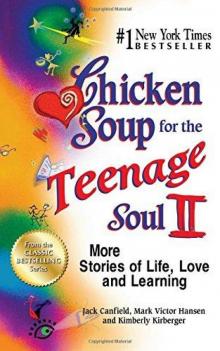 Chicken Soup for the Teenage Soul II
Chicken Soup for the Teenage Soul II Chicken Soup for the Girl's Soul
Chicken Soup for the Girl's Soul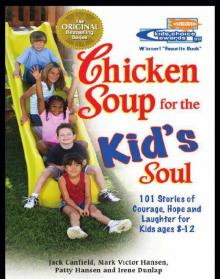 Chicken Soup for the Kid's Soul: 101 Stories of Courage, Hope and Laughter
Chicken Soup for the Kid's Soul: 101 Stories of Courage, Hope and Laughter Chicken Soup for the Woman's Soul
Chicken Soup for the Woman's Soul Chicken Soup for the Cancer Survivor's Soul
Chicken Soup for the Cancer Survivor's Soul Chicken Soup for the Canadian Soul
Chicken Soup for the Canadian Soul Chicken Soup for the Military Wife's Soul
Chicken Soup for the Military Wife's Soul A 4th Course of Chicken Soup for the Soul
A 4th Course of Chicken Soup for the Soul Chicken Soup Unsinkable Soul
Chicken Soup Unsinkable Soul Chicken Soup for the Soul: Christmas Magic
Chicken Soup for the Soul: Christmas Magic Chicken Soup for the Grandma's Soul
Chicken Soup for the Grandma's Soul Chicken Soup for the Soul: All Your Favorite Original Stories
Chicken Soup for the Soul: All Your Favorite Original Stories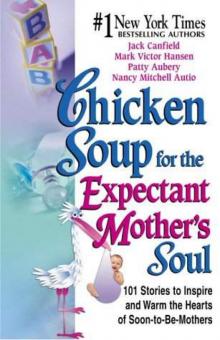 Chicken Soup for the Expectant Mother's Soul
Chicken Soup for the Expectant Mother's Soul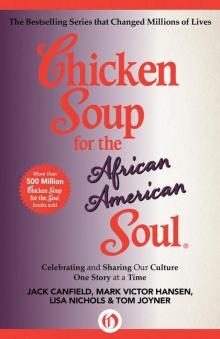 Chicken Soup for the African American Soul
Chicken Soup for the African American Soul 101 Stories of Changes, Choices and Growing Up for Kids Ages 9-13
101 Stories of Changes, Choices and Growing Up for Kids Ages 9-13 Christmas Magic
Christmas Magic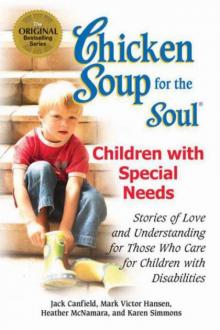 Chicken Soup for the Soul: Children with Special Needs
Chicken Soup for the Soul: Children with Special Needs Chicken Soup for the Soul: Country Music: The Inspirational Stories behind 101 of Your Favorite Country Songs
Chicken Soup for the Soul: Country Music: The Inspirational Stories behind 101 of Your Favorite Country Songs Chicken Soup for the Country Soul
Chicken Soup for the Country Soul Chicken Soup for the Recovering Soul Daily Inspirations (Chicken Soup for the Soul)
Chicken Soup for the Recovering Soul Daily Inspirations (Chicken Soup for the Soul) A 3rd Serving of Chicken Soup for the Soul
A 3rd Serving of Chicken Soup for the Soul The Book of Christmas Virtues
The Book of Christmas Virtues Chicken Soup for the Soul at Work
Chicken Soup for the Soul at Work Chicken Soup for the Soul 20th Anniversary Edition
Chicken Soup for the Soul 20th Anniversary Edition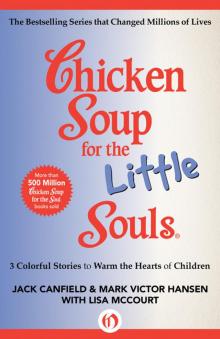 Chicken Soup for the Little Souls
Chicken Soup for the Little Souls Chicken Soup for the Soul: Reader's Choice 20th Anniversary Edition
Chicken Soup for the Soul: Reader's Choice 20th Anniversary Edition Chicken Soup for the Soul Christmas
Chicken Soup for the Soul Christmas Taste of Chicken Soup for the Teenage Soul III
Taste of Chicken Soup for the Teenage Soul III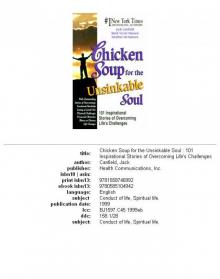 Chicken Soup for the Unsinkable Soul
Chicken Soup for the Unsinkable Soul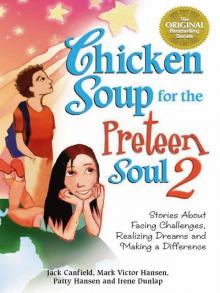 Chicken Soup for the Preteen Soul II
Chicken Soup for the Preteen Soul II